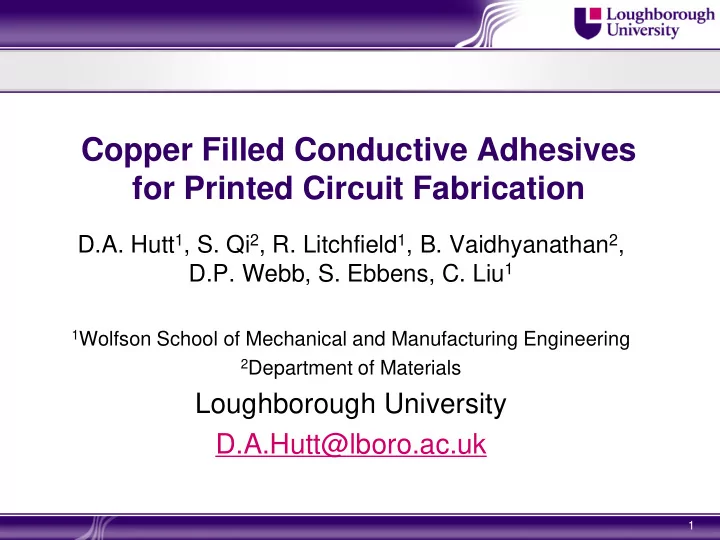

Copper Filled Conductive Adhesives for Printed Circuit Fabrication D.A. Hutt 1 , S. Qi 2 , R. Litchfield 1 , B. Vaidhyanathan 2 , D.P. Webb, S. Ebbens, C. Liu 1 1 Wolfson School of Mechanical and Manufacturing Engineering 2 Department of Materials Loughborough University D.A.Hutt@lboro.ac.uk 1
Outline Introduction Copper as a substitute for Silver Copper Conductive Adhesive Preparation Characterisation of Printed Tracks Alternative Curing Methods Reliability Functional Circuit Fabrication Conclusion 2
Introduction Printing now applied to most areas of electronics Conductors, components, displays Aim to achieve Low cost High volume, e.g. reel to reel processing Agility, e.g. low volume prototypes Substrate variety, e.g. polymers, FR4 Reliability Many conductor inks based on silver Lower cost / more abundant alternatives needed 3
Printed Conductors Nanoparticle based inks sinter Inkjet print nanoparticles and sinter Conductive inks and adhesives based on micron sized particles or flakes Screen / stencil Conductive Curing particle print and cure adhesive e.g. 80 O C – 150 O C Printing and component assembly steps – often separated 4
Copper as a Substitute for Silver Conductive adhesives / inks rely on low resistance metal to metal contact Silver widely used: Ag oxide has good conductivity Copper offers lower cost Oxide layer Metal Direct substitution particle problematic Copper surface oxidation results in poor conductivity 5
Copper Powder Preservation Copper powder treatment method developed Remove oxide and apply protective coating Self-assembled monolayer (SAM) SAM coating Cu oxide SAM Cu etch Cu Cu Cu coating Adhesive Enables powder to be stored in air (in freezer) for several weeks Bare Cu Coating breaks down during Cured Adhesive thermal cure – metal to metal contact 6
Copper Conductive Adhesive Etched and applied protective SAM coating to spheroidal copper powder Average 10 µ m particle size Powder stored in the freezer for several weeks Conductive adhesives prepared Two formulations of epoxy adhesives tested One part adhesive – cure for 60 min @ 150 o C Two part adhesive – cure for 15 min @150 o C Both 85.7 wt% Cu loading 7
Thermal Curing Procedure Stencil printed stripes of Cu adhesive on glass Curing (150 o C) under an inert (Ar) atmosphere Poor conductivity if cured in air Resistivity measured using four point probe Ar outlet Rubber tube Glove box Samples ~2 cm Ar inlet Oxygen Hot plate analyzer 8
Resistivity of Fully Cured Samples 2.1 Cu paste A (Cu mixed with resin A) Cu paste B (Cu mixed with resin B) Commercial Ag paste 1.8 Resistivity / 10-4 Ohm.cm 1.5 1.2 0.9 0.6 0.3 0.0 One-part Commercial Two-part resin Ag resin resin Cured copper samples show low resistivity One part resin – best results Comparable to commercial Ag filled adhesive 9
Microstructure Shrinkage of the adhesive leads to reduced resistivity Resistivity / 10 -4 Ohm.cm 9 8 7 5 min cure 6 5 4 3 2 1 0 0 10 20 30 40 50 60 Curing time / min 60 min cure 10
Microwave Curing Microwave curing has also been investigated Using an inert atmosphere Aim to improve the thermal profile Microwave cavity Thermal imaging camera Ar outlet Quartz tube Sample holder Ar inlet 11
Microwave Curing Comparable resistivity and microstructure achieved, but in shorter curing time 9 Conventional curing Resistivity / 10-4 Ohm.cm Microwave curing 8 7 6 5 4 3 2 1 20 min cure 0 0 10 20 30 40 50 60 Curing time / min 12
Reliability Storage in ambient environment leads to small increase in resistivity Approx. 6 to 7% increase in 6 months 85 o C / 85% relative 90 Commerical Ag paste Resistivity / 10 -4 Ohm.cm 85 humidity testing Cu paste A (No coating) Cu paste A (Conformal coating) 80 Exposed tracks 75 show large 70 change in resistivity Tracks protected 5 with a conformal coating show much 0 greater reliability 0 5 10 15 20 25 Aging time / h 13
Circuit Printing and Assembly blade Cu paste deposit stencil paste Stencil print copper paste on substrate Thermal Cure Functional circuit Place components into uncured paste Combining circuit formation and component interconnection into a single process 14
Functional Copper Circuits Single layer test circuits prepared using stencil printing and component placement Low cure temperature enables polymer substrates to be used Glass substrate 15
Conclusion Copper as an alternative to Ag in printed electronics is challenging Using organic coatings Cu can be preserved for use in conductive adhesives Reliability of Cu adhesives requires further investigation Microwave heating can speed up the curing process Functional circuits demonstrated combining printing and assembly 16
Acknowledgements EPSRC for funding through the Innovative Manufacturing and Construction Research Centre (IMCRC) Materials Research School, Loughborough University for PhD studentship funding 17
Thank you for your attention 18
Recommend
More recommend